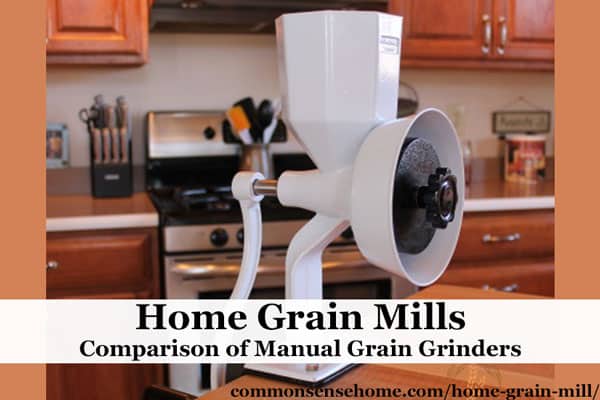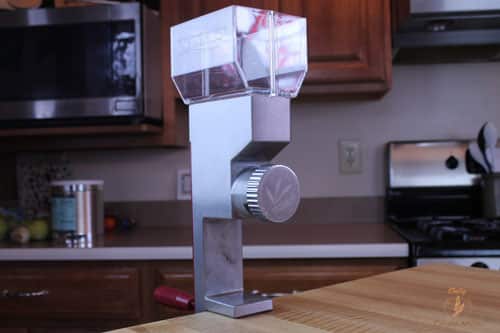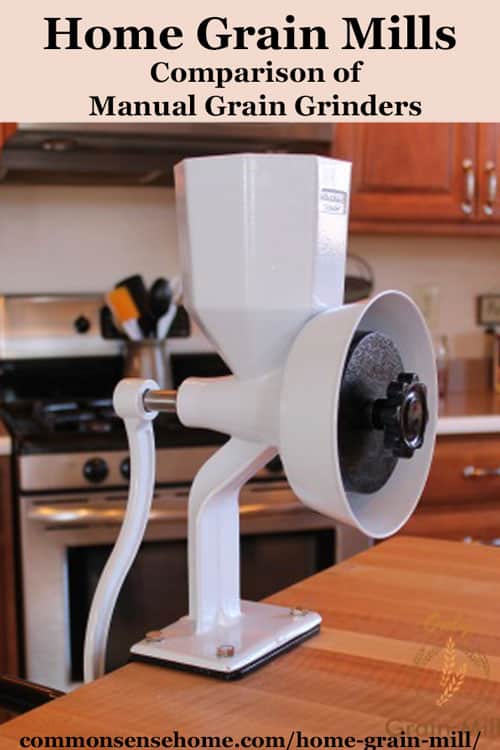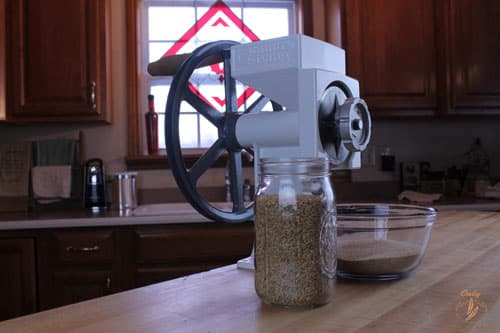Home Grain Mills – Comparison of Manual Grain Grinders
This post may contain affiliate links. Read my full disclosure here.
Whole grains are affordable, last longer in storage and can provide excellent flavor and quality. That said, you can’t use these grains to their full potential without a home grain mill. Manual flour mills tend to be less expensive than their powered cousins, but still get the job done. For light amounts of grain grinding or an off grid situation, a manual grinder is a solid choice.

What is a Grain Mill?
Essentially, flour milling remains unchanged from what Ancient Egyptians or even the American colonials used in their day. Two rough surfaces (usually stones) grind against one another to pulverize the wheat or other material into a powder.
Previous generations had issues such as millstone grit in their breads that wore down their teeth. Thankfully, modern grain mills take the concept of grinding surfaces and use modern materials and technology to produce a clean, consistent product.
Modern home grain mills:
- Can be powered either by hand or by electricity
- Use a variety of materials ranging from composite stones to surgical and stainless steel burrs
- Grind a wide variety of ingredients into highly nutritious ingredients and foods
- Are typically quite durable and portable
Why Do I Need a Grain Mill?
There are a variety of reasons, depending on your focus and needs, to keep a grain mill handy in your kitchen.
Freshly Ground Flour Provides Better Nutrition
Modern flour is a highly processed food. Most of the inner portions of the wheat berry (the parts necessary for the initial burst of nutrition the plant would need) are removed in order to keep the flour fresh for months on a store shelf. The resulting flour is then “enriched” with artificial vitamins to make up the difference.
Compare this nutritionally-deficient industrial stuff to flour you grind at home. Since you don’t need to keep flour on a shelf in a bag for weeks, you can grind up enough for each recipe as you need it. The original nutrients stay in the flour – no enrichment required.
Use your home milled flour to make bread, cakes, and cookies, and store the rest of the wheat until needed. (To get even more nutrition, check out working with sourdough recipes such as sourdough bread and crackers.)
You Can Be More Self-Sufficient (Now and During Emergencies)
Buying grain in bulk is cheaper than buying flour. You can also store grain for decades if you stash it properly. (Read more on buying grains in bulk and proper storage here.)
This means that money spent now on food will feed your family for many years to come. Food prices tend to go up, not down, so this is a good investment.
If our economic or political situation turns dark and it becomes a major undertaking to go to a store and buy food (presuming food is available, of course), long term food storage will be even more important. (Venezuelans can testify to this.) In that case, having a grain mill that you can use to grind flour will help keep you and your family fed.
In a short term emergency with an extended power outage, you’ll want manual tools to get jobs done. The right grain mill can tackle not only grain, but tasks like grinding peanut butter, too.
You can make your own flour, grind corn meal, grind coffee (including herbal coffees), make peanut butter or seed butters… Once you get in the habit of using it, you’ll wonder how you did without it.
Have More Uses for the Materials You Grow Yourself
A sturdy mill isn’t just for grinding wheat and rice. You can also use it as a corn grinder to make your own corn meal, or to grind dried beans for bean flour. Sunflower seeds, pepitas, almonds, peanuts and a variety of small grains can all be ground for flours or spreads.
Which Home Grain Mill is the Best for Me?
That question only you can answer, since only you know the needs unique to your situation. However, here are some pros and cons of popular manual grain mills.
Would you like to save this?

The Victorio Brand (AKA Back To Basics)
The Victorio brand comes in two flavors, the Basic and the Deluxe. The Basic is best suited to be a backup mill, though in a pinch it could be the main mill for a single person. It’s bigger brother the Deluxe can be a main mill for a couple, though again I’d rather use it as a backup.
- They grind easily, and the grind gives you good quality bread flour. You can also grind more coarsely for cereals and such.
- Both units clamp to a sturdy surface using a table clamp on the bottom of the mill.
- They cannot grind whole corn kernels and cannot handle hard popcorn at all. Best for wheat or rice, since they cannot handle anything with oil or moisture content.
- If you plan on grinding sprouted wheat be sure to dry it out thoroughly first, or the residue will eventually clog the Victorio mills.
- They come with 2 year manufacturer’s warranties, and are excellent buys for the money. However, a family will need a more durable mill since these mills only recommended for occasional small-quantity grinding.

The WonderMill Junior Deluxe
The WonderMill Junior Deluxe is an excellent mix of durability, versatility, and portability.
- The double-clamp it uses for stability is very gentle on the table edge (provided it’s not over-tightened).
- Fully assembled it weighs about 10 pounds, owing to its lightweight aircraft-aluminum body.
- The food-grade coating keeps the aluminum from contacting the food, and since there’s nothing that can rust in the grinding mechanism, it’s easy to clean off flour dust and the like just by running the whole mill under a faucet.
- The best part of the WonderMill Junior Deluxe is the grinding burrs.
The Deluxe comes standard with two sets of burrs: one stone for dry grains like wheat and rice, and the other a stainless steel set meant for oily grains, coffee beans and fresh peanut butter.
It’s the only mill that can boast excellent grinding of such a wide range of ingredients, from hard popcorn to oily and gooey peanut butter, just by switching the burrs around for the proper grind.
It grinds finely, giving you high-quality bread flour or very smooth peanut butter, and can be backed off to grind coarse if you want cornmeal and other grittier foods.
It has a limited lifetime warranty, which covers everything but the wearable stone burrs and the brass bushings. I’d recommend this mill for anyone, as it covers most needs and will last a long time.

The Country Living Grain Mill
The Country Living Grain Mill is a famous mill, and for good reason: it’s one of the largest and most durable mills on the market. Weighing in at 20 pounds and covered by a limited lifetime warranty, it is best described as solid.
It has been made in the U.S.A. for decades, and for grinding dry grains there is no better mill. It’s burrs are made of stainless steel and specially designed to get you one of the finest grinds possible on a grain mill.
It doesn’t include a clamp (though one is optionally available) because most people prefer to bolt it directly to their grinding surface to take advantage of its finely machined grinding mechanism for motorizing with the included pulley.
I’ve seen Country Livings attached to motors or to exercise bikes: the smooth action of the mill makes it excellent for motorizing. Its only weakness is oily seeds, as it is rather hit-or-miss with them.
Some of the less oily seeds it seems to handle alright, but something like coffee or peanut butter will gum it right up. Recommended for motorization option and/or for anyone who wants to grind dry grains.
You may also enjoy:
- 13 Homemade Bread Recipes – Never Buy Bread Again
- Troubleshooting Tips to Help Bake the Perfect Loaf of Bread
- Best Ever Corn Bread Recipe
- Nutrimill Grain Mill Comparison (for an on-grid option instead)
This post was originally written in cooperation with the company “Only Grain Mills” back in 2013. It was updated in 2015 and 2017 with more detailed content and links to their site removed. I no longer recommend their shop. Two readers ran into problems when ordering from them. They are the reason we rarely partner with companies unless we can test a product or service first.

I’m interested in a stone grinder made in the U.S.A.
Suggestions?
As mentioned, the Country Living mills are made in the USA, but they are not stone. Pleasant Hill Grain has commercial grade stone mills that are made in the USA, but the prices currently start at over $2000 (for the 8 inch) and go up from there.
I did find Nugget grain mills that are a hand crank mill made in Utah. It looks like they come default with stone burrs that can be upgraded to stainless steel. Those are priced closer to $200.
Diamante grain mill
Waiting on my Diamante from Poland! (tryed to download photo)
How long is the wait? I know Lehman’s has been struggling to get items in stock.
Please give me prices, off grid hand grinder
I don’t sell the grinders. You’d need to follow the links in the article to check current prices at places that sell them.
on grinding your own flour, how long can you store unground grain and corn for?
am living in montana. would like to recommend a local made grain mill. although expensive, it is an outstanding mill. it is the “GRAIN MAKER”. made here in montana. web site is “grainmaker.com” submitted for your consideration.
thank you for your web site. it has answered many questions raised in other sites and never answered or covered.
Wheat berry and dent corn storage estimates vary greatly depending on the source. Some places say only a year. Prepper sites generally lean towards 20 – 30 years if sealed in airtight containers with oxygen absorbers in cool dry conditions.
would request you look at “grainmaker.com”. excellent mill made in montana. not cheap, but very good quality. and two sizes.
Thanks for the tip.
Has anyone tried grinding flour with a Cuisinart Supreme Burr Mill? It is sold as a coffee mill and the manufacturer recommend limiting it use to coffee beans but it seems like a mill that can grind coffee beans might also easily handle, e.g., wheat berries? Anyone have an opinion?
Coffee mill motors are simply not built for grinding the amount of grain required with baking. You may even void the warranty. You could use one in a pinch, but I wouldn’t buy in with the intention of making it a personal grain mill.
Thank you, Laurie.
You’re welcome, Jim.
Hi, we are a big family and we want to make our own flour and bread. I dont understand english very well. But I understand your recommed is 3rd and 4th for a big family? Please help me to choose better mill. Which mill I must buy from amazon?
For a large family and heavy use, I would recommend the Country Living Hand Grain Mill (affiliate link). It is very strong and built to last.
I also was wondering about the kitchenaid attachment. Have you any news or personal experience?
No, I haven’t tried that one out. Right now I have a Nutrimill. The attachment has gotten quite a few negative reviews on Amazon, with people that it grinds too coarsely and strips the gears on the mixer.
Any ideas on where to buy your wheat to grind?
There are several bulk buying clubs listed on the resources page that carry bulk grains – https://commonsensehome.com/resources/ UNFI, Azure Standard and Country Life are ones that I know offhand. You can also buy directly from the mills in some cases.
Emergency Essentials, one of my affiliates (link on sidebar), also carries bulk grains.
Has anyone tried the kitchen aide attachment kind? My husband was going to get it for me.
Hi, Lee! Did you ever act on this? We recommend you take a look at our brand-new Mockmill. Here’s a video posted by an independent group.
I read several reports of it burning out your mixer ‘s motor. I would not try it. Those mixers are too expensive to break because of using the grinding attachment.
Judy, pretty unkind to refer to “several reports” and not name any of them. We haven’t received a SINGLE ONE, with more than 2000 mills delivered. Would you care to be specific in your warnings to the public?
It would seem that these 3 were reviewed as they are sold at this one site, from which the reviews originally came. Unfortunately, what it doesn’t mention is where they are manufactured. I teach self-sufficiency skills, and I no longer recommend the Wonder Mill, as they are now made in China,e ven though the price remains about $200.
I do not know where the Victorio, a.k.a., “Back to Basics”, is made, but I don’t think it is a U.S.-made product.You can buy the lesser Victorio’s for as little as $30 off ebay, amazon, etc., but pay closer to $100 for the better model, not including shipping.
If you just want an inexpensive, American made hand unit that works very well, I suggest the Lehman’s product (about $200), even though it does have cast iron burrs and requires care in keeping dry, as does any cast iron. It works very well for just about anything you’d like to grind.
The Country Living (white), like it’s closest competitor, the GrainMaker (red) are the “big boys” and are both American-made quality, built to last through generations. However, they are not in everyone’s budget, as you will easily spend in the neighborhood of $500-$700 for all peripherals.
Does it matter? Well, I still believe it’s important to support made in the U.S.A., and I still believe in the best bang for the buck – which is NOT Made in China, IMHO.
And, like so many things, you always get what you are willing to pay for.
Just another part of the equation when deciding on a grain mill.
I wish these more expensive, American-made mills had sales now and then. I would think that many people would buy, therefore pleasing these companies. Older single gals like sales! If you know of these companies ever having sales, please send me a note. It’s important to me: to buy USA, for numerous good reasons; for mostly good reviews; for a truly healthy (non-exposed aluminum, plastic pieces, real-stone grinder) mill; and, of course, a decent price for what I’m getting. I’m not exactly rich, so if they had a good deal going on……
We have grown our own dent corn and wanted to make grits, but the mill we borrowed ground it too finely – even on the coarse setting. Does anyone how which mill will allow us to make grits AND flour?
Thanks,
Laurel
I’ll ask Josh about this.
Josh says: “Either the Wonder Junior Deluxe or the Country Living Grain Mill can grind flour and grits very well. We personally prefer the Wonder Junior because it can also grind oily seeds and nuts, and because it includes the table clamp with the mill.”
It’s worth noting that baking with fresh ground flour is NOT like baking with store bought flour. 🙂 Unless you have one of those heavy mills, the grind is not quite as fine as with store bought. More importantly, though, it’s WETTER. The first time I made bread with fresh ground flour, I followed my usual recipe… and discovered I had batter, not bread dough. LOL! It’s a bit of trial-and-error to find the right combination of flour to water for your area, but well worth it. Fresh baked bread from fresh ground flour is a flavor that CANNOT be beat. 🙂
Very true! That’s one of the reasons I included links to recipes and recipe book at the bottom of the post. Even though I often use a mix of flours, the boys have gotten to the point where they can often identify which flours were used. Grinding your own adds a whole new element to baking.